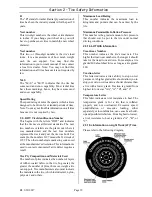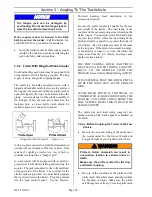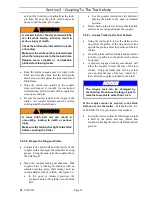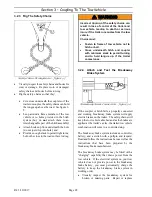
Section 3 – Coupling To The Tow Vehicle
R4 3/30/2017
Page 22
the weight of the trailer and all of the items within it
(such as cargo, water, food and other supplies).
GVWR is sometimes referred to as GTW (Gross
Trailer Weight), or MGTW (Maximum Gross
Trailer Weight). GVWR, GTW and MGTW are all
the same rating.
GAWR:
The Gross Axle Weight Rating is the
maximum gross weight that an axle can support. It
is the lowest of axle, wheel, or tire rating.
Sometimes the tire or wheel rating is lower than the
axle manufacturers rating, and will then determine
GAWR.
The sum total of the GAWR for all trailer axles may
be less than the GVWR for the trailer, because
some of the trailer load is carried by the tow
vehicle, rather than by the trailer axle(s).
The total
weight of the cargo and trailer must not exceed
the GVWR, and the load on an axle must not
exceed its GAWR.
PSIC:
The “pounds per square inch-cold” is the
tire pressure (Kilopascals / Pounds per Square Inch)
measured when Cold.
VIN:
The Vehicle Identification Number.
VEHICLE TYPE:
Trailer plus the model number
of the trailer.
Certification Statement:
“This trailer meets all
the Federal Motor Vehicle Safety Standards in
effect on the date of manufacture shown above.”
There are two additional weights that are not
provided on the Certification (VIN) tag that are
important, and that should be put somewhere on the
trailer. These are the “empty weight” and
“maximum cargo weight”.
The “empty weight” is sometimes put on the
Manufacturer’s Certificate of Origin (Title) but may
not be accurate for your particular trailer, due to
accessories, optional equipment, etc. The best way
to determine empty weight is to weigh the entire
trailer on a “Certified” scale at a truck stop. This
requires detaching the trailer and leaving the entire
trailer on the scale. Furthermore, it is desirable to
weigh the tongue weight. This can be done by re-
attaching the trailer to the tow vehicle, after getting
the empty weight, and then just weighing the trailer
axles. Subtracting the axle weight from the empty
weight gives you the tongue weight.
Knowing the empty weight now allows you to
calculate the “maximum cargo weight”. Simply
subtract the empty weight from the GVWR shown
on the Certification / VIN tag.
While you’re at the scale it is also a good idea to
weigh the towing vehicle, with driver, in the typical
towing scenario. This will provide you with the
total “combination vehicle weight”, which can then
be compared to the allowable Gross Combined
Weight Rating (GCWR) provided by the tow
vehicle manufacturer, as discussed below.
3.1.2 Tow Vehicle
When equipping a new vehicle or an older vehicle
to tow your trailer, ask the vehicle dealer for advice
on how to outfit the towing vehicle. Discuss the
following information and equipment with the
vehicle dealer.
Overall Carrying and Towing Capacity of
Vehicle:
Vehicle manufacturers will provide you
with the maximum towing capacities of their
various models, as well as the GCWR. No amount
of reinforcement will give a 100 horsepower, 2,500
pound truck the towing capacity that a 300
horsepower, 5,000 pound truck has.
Towing Hitch:
The towing hitch attached to your
tow vehicle must have a capacity equal to or greater
than the load rating of the trailer you intend to tow.
The hitch capacity must also be matched to the tow
vehicle capacity.
Suspension System:
A tow vehicle equipped with
a factory installed “Towing Package” likely comes
equipped with heavy duty springs, heavy duty tires
and other suspension components which are able to
serve the size and weight of the trailer that the
vehicle is rated to tow. However, the addition of
additional equipment may further improve the tow
vehicle performance. These may include adjustable
air shocks, helper springs, etc.
Brake Controller:
The brake controller is part of
the tow vehicle and is essential in the operation of
the electric brakes on the trailer. If your trailer has
electric brakes it requires a brake controller be
installed at the driver’s position. The brake
Summary of Contents for COACH TRAILERS
Page 1: ...COACH TRAILERS OWNER S MANUAL...
Page 6: ......






























